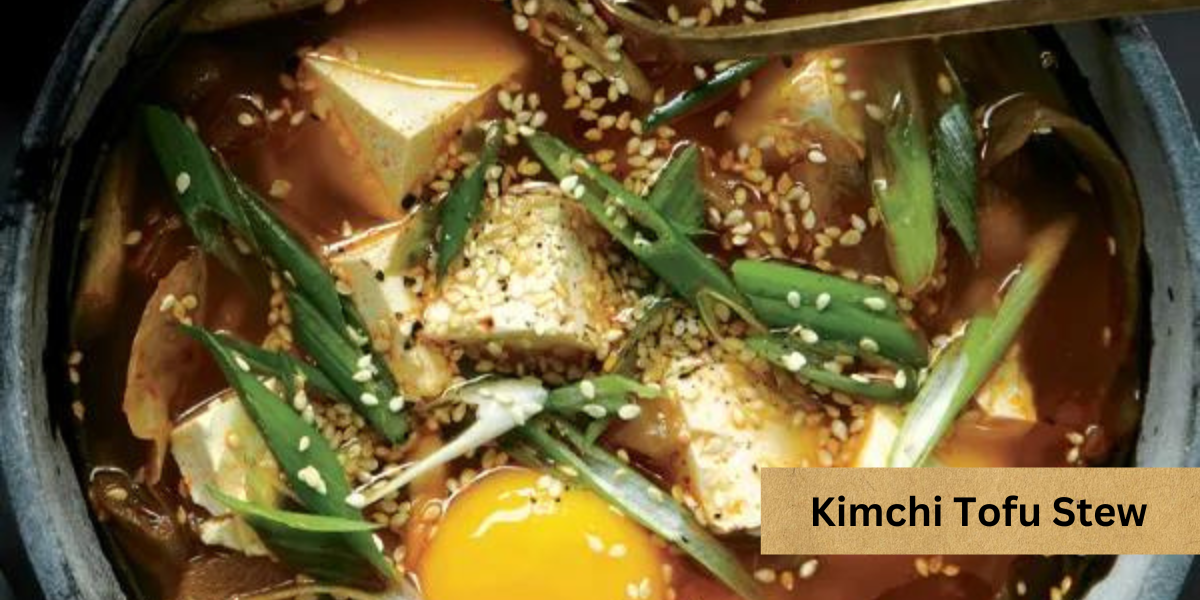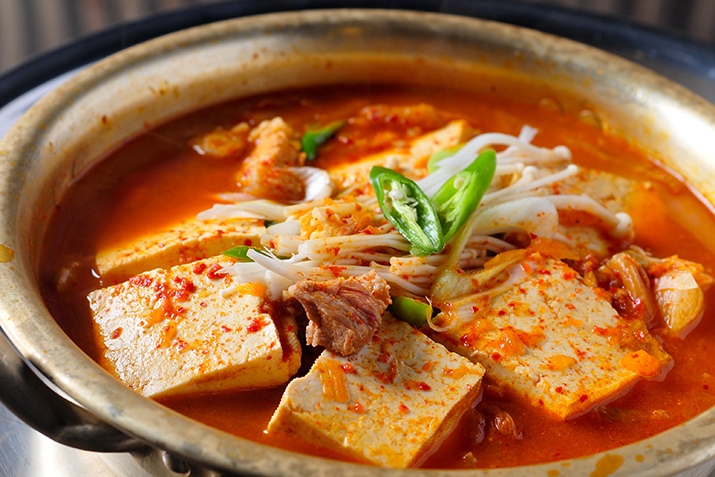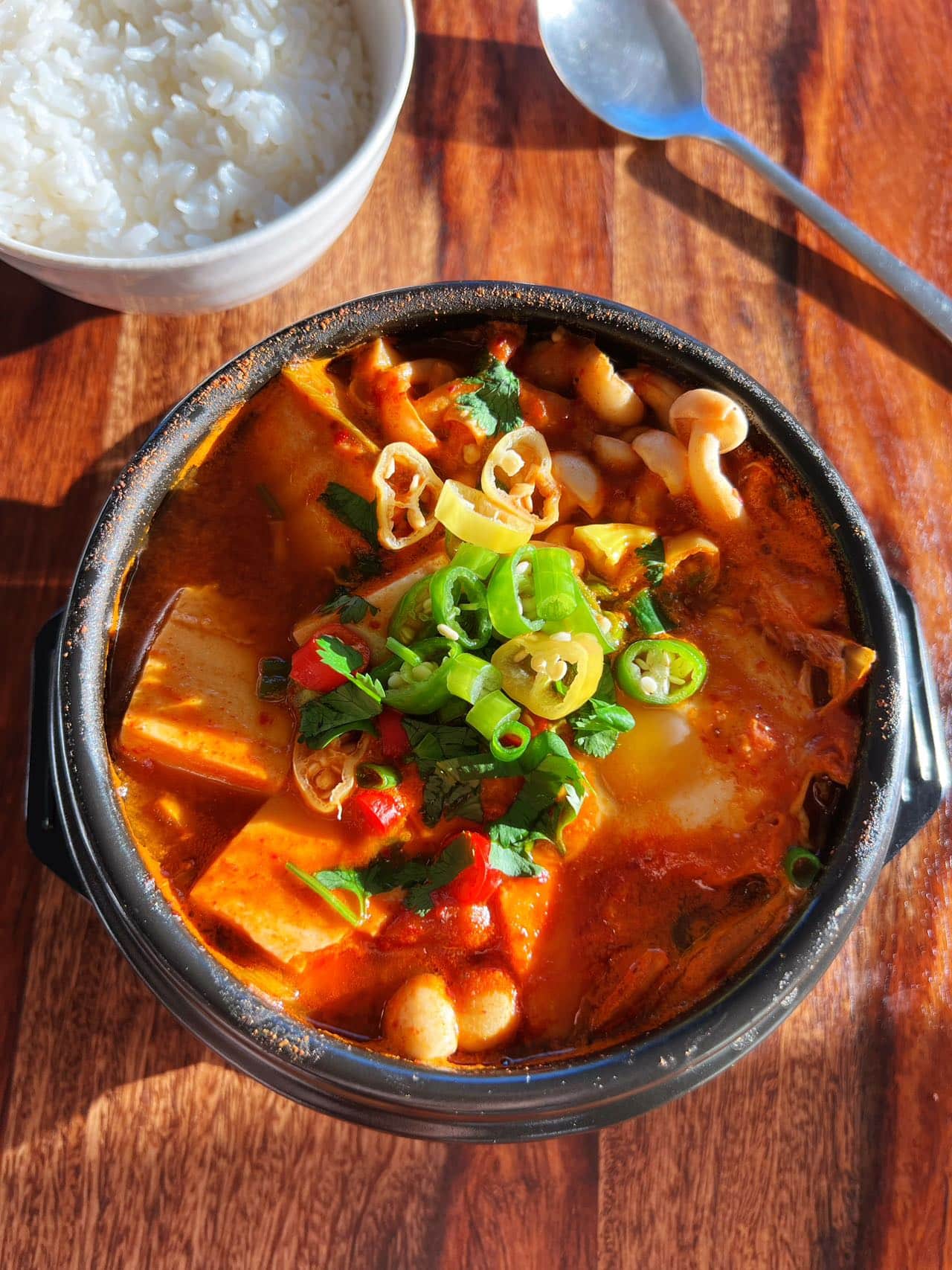Ingredients: Here’s what you’ll need to make Kimchi Tofu Stew:
- 2 cups of aged kimchi, chopped
- 1 block of firm tofu, cubed
- 200g of pork belly or pork shoulder, thinly sliced (optional)
- 1 small onion, thinly sliced
- 3 cloves of garlic, minced
- 2 tablespoons of Korean chili flakes (gochugaru)
- 1 tablespoon of Korean chili paste (gochujang)
- 1 tablespoon of soy sauce
- 1 tablespoon of sesame oil
- 4 cups of water or broth
- Sliced scallions for garnish
1. Prep the Ingredients:
- Start by preparing all the ingredients. Chop the kimchi into bite-sized pieces, cube the tofu, thinly slice the onion, mince the garlic, and thinly slice the pork (if using).
2. Sauté the Aromatics:
- Heat a large pot over medium heat and add a drizzle of oil. Once hot, add the sliced onion and minced garlic, sautéing until fragrant and translucent.
3. Add the Kimchi:
- Add the chopped kimchi to the pot, stirring to combine with the aromatics. Allow the kimchi to cook for a few minutes until it becomes slightly caramelized and aromatic.
4. Incorporate the Pork (Optional)
- If using pork, add the thinly sliced pork belly or pork shoulder to the pot, stirring to combine with the kimchi mixture. Cook until the pork is lightly browned and cooked through.
5. Season the Stew:
- Add the Korean chili flakes (gochugaru) and Korean chili paste (gochujang) to the pot, stirring to coat the ingredients evenly. Then, add the soy sauce and sesame oil, stirring to combine.
6. Add the Tofu and Liquid:
- Gently add the cubed tofu to the pot, being careful not to break it apart. Pour in the water or broth, ensuring that the tofu is submerged in the liquid.
7. Simmer the Stew:
- Bring the stew to a gentle simmer over medium-low heat, allowing it to cook for about 15-20 minutes. This will allow the flavors to meld together and the tofu to absorb the delicious broth.
8. Garnish and Serve:
- Once the stew is ready, taste and adjust the seasoning if needed. Garnish with sliced scallions for a pop of color and freshness.
- Serve the Kimchi Tofu Stew hot, straight from the pot, alongside steamed rice or other Korean side dishes for a complete meal.
9. Enjoy:
- Dive into each bowl of Kimchi Tofu Stew, savoring the rich flavors and comforting warmth with every spoonful. Enjoy the bold tanginess of the kimchi, the creamy texture of the tofu, and the savory goodness of the pork (if included).
FAQs
1. What is Kimchi Tofu Stew?
- Kimchi Tofu Stew, also known as “Kimchi jjigae” in Korean cuisine, is a traditional Korean stew made with fermented kimchi, tofu, and other ingredients. It is known for its bold and tangy flavor, hearty texture, and comforting warmth.
2. What are the key ingredients in Kimchi Tofu Stew?
- The key ingredients in Kimchi Tofu Stew include aged kimchi, firm tofu, pork belly or pork shoulder (optional), onion, garlic, Korean chili flakes (gochugaru), Korean chili paste (gochujang), soy sauce, sesame oil, and water or broth.
3. Is Kimchi Tofu Stew spicy?
- Kimchi Tofu Stew can vary in spiciness depending on the amount of Korean chili flakes (gochugaru) and Korean chili paste (gochujang) used in the recipe. Some versions of the stew may be quite spicy, while others may have a milder heat level.
4. Can I make Kimchi Tofu Stew vegetarian or vegan?
- Yes, Kimchi Tofu Stew can easily be made vegetarian or vegan by omitting the pork and using vegetable broth instead of water. The stew will still be flavorful and satisfying without the meat.
5. How do I store leftovers of Kimchi Tofu Stew?
- Leftover Kimchi Tofu Stew can be stored in an airtight container in the refrigerator for up to 3 days. Simply reheat the stew gently on the stovetop or in the microwave before serving.
6. Can I freeze Kimchi Tofu Stew?
- While Kimchi Tofu Stew can be frozen, the texture of the tofu may change slightly upon thawing. If you choose to freeze the stew, allow it to cool completely before transferring it to freezer-safe containers. It can be stored in the freezer for up to 2-3 months.
Conclusion:
In conclusion, One-Pot Creamy Kimchi Shells is a shining example of culinary innovation and creativity. By combining the comforting creaminess of pasta with the bold and tangy flavors of Korean kimchi, this dish offers a unique and unforgettable dining experience that transcends cultural boundaries. Whether enjoyed as a quick weeknight meal or as a centerpiece of a dinner party menu, One-Pot Creamy Kimchi Shells is sure to captivate taste buds and inspire culinary adventures for years to come.
Also Read: Tteokbokki



